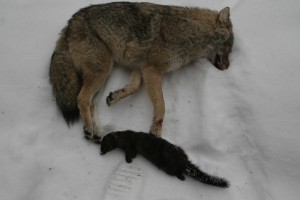On the Hunt: Raging Brook keeps skittish hares on the run
Although we had some cold temperatures with a couple below zero mornings, we still had another non-winter week with only a trace of snowfall.
The trails in the woods are holding their own but the ones exposed to the sun are quickly becoming dirt.
The cross-country skiing has been nothing but fast as it is hard to keep control on top of the icy crust.
I got out the other day with Doug Riedman and his wonder hound Brook to chase some Snowshoe Hares around. We didn’t do much chasing, but Brook sure did.She’s only eight months old and she sure likes to hunt. All we could see was a blur of white as she pushed the Hare past us at top speed.
When you hunt Hares with a 22, as I do, you have to be a pretty good shot to get one at that speed. The first day I saw one Hare but did not get a shot at it.
On the second day we weren’t one hundred feet in the woods before Brook had one on the run. It was nonstop baying for three hours after that.
I saw three Hares that day and had only one quick shot as one crossed the ski trail. It was a stray that got spooked out of the woods where Brook was running, but I missed it.
It was nice to get back out in the woods and hear the sound of a hound on the chase. We had to catch her or we would have been out there all night. That young dog is all hunt.
This time of the year my hands, like those of many others, get chapped from having them in animal fat and in and out of water setting traps.
I’ve heard many others complain about their cracked hands and fingers. A little Bag Balm can help. It comes in a little tin can and is sold locally at Kinney Drugs.
I’ve used this for years, way back when I was just a kid milking cows. The cows’ udders would get chapped from getting wet and dry and just hanging out in the cold.
When we treated them with Bag Balm we’d get it on our hands, so it worked for us in the same way.
Try it. I think you will like it, and so will your hands.
This year, the DEC extended the trapping season for Coyotes, Foxes and Raccoon on land until February 15th.
The snow conditions haven’t been the best for setting traps.
It seems as soon as you get them out and in place, it rains and they freeze up again.
This week, however, has been the best with the little light snow each night combined with the cold temperatures.
A good place to set traps is near the site of where these critters have killed a Deer or another prey.
Don’t place it on the carcass, rather circle far away in an area where the critters will be approaching from.
Place your traps in a footprint one side or the other from your snowshoe track.
Dig out the track and place your trap. Crumple up a piece of wax paper, then flatten it over the trap pan.
Use a cedar shingle to cover the trap, then cover it with a little light snow and move on.
Years ago, I caught three Red Fox in one night around one carcass. The fur on these animals is prime and beautiful. One night this week I caught a nice coyote in one such set.
There are still lots of birds feeding out in the woods. Most everywhere I walk, I stop and call in some Chickadees, Nuthatches, Kinglets, and for sure, some Siskins.
They are feeding on the Yellow Birch Seeds and also the cone seeds of Red Spruce and Hemlock. When they are feeding they are pretty silent but for a few chips now and then.
I heard and saw a White-winged Crossbill singing in a tree outside the Health Center in Old Forge yesterday (2/13). I saw a pair of Red Crossbills picking grit in the Limekiln Road last week, so they are around.
I’m sure some of the Siskins and Crossbills are nesting due to all the Red Spruce cones available as a food supply. They use these seeds to feed their young.
I can’t imagine sitting on eggs at ten below zero, but they do. There must be lots of energy packed in cone seeds.
At one place I was walking last week I got bombed with cones by a Red Squirrel that was cutting from the top of tree. He had the ground littered with hundreds of cones.
Rather than eating them at tree top level where he would be exposed to hawks, he cut them off and dropped them on the ground for safer eating. This is the time to travel to new places in the woods, but that’s another story. See ya.

